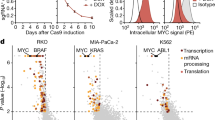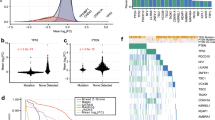Abstract
A novel cell growth regulator, named Falkor, was identified using a functional approach to mammalian gene cloning, the Genetic Supressor Elements (GSE) method. In this screen, expression of the C-terminal domain of Falkor conferred cells with resistance to cisplatin-induced growth arrest. Expression of the C-terminus of Falkor, but not of the full-length protein, enhanced cell growth both following genotoxic stress and under normal conditions suggesting a general role for this protein in cell growth control. This effect of the C-terminus fragment was abrogated by over-expression of the full-length Falkor, suggesting that the fragment counteracts the function of the full-length protein. Falkor is encoded by a 2-kb mRNA which is present at different levels in various tissues, and is localized in the nucleus of cells. The C-terminal domain of Falkor, isolated from the GSE library, has significant homology to a known human and rat cell growth regulator, SM-20, and to the C. elegans protein EGL-9, recently shown to modify the Hypoxia Inducible Factor-1α. The homology suggests that these proteins share a functional domain that is conserved among a family of growth regulation proteins.
This is a preview of subscription content, access via your institution
Access options
Subscribe to this journal
Receive 50 print issues and online access
$259.00 per year
only $5.18 per issue
Buy this article
- Purchase on Springer Link
- Instant access to full article PDF
Prices may be subject to local taxes which are calculated during checkout






Similar content being viewed by others
References
Amundson SA, Myers TG, Fornace Jr AJ . 1998 Oncogene 17: 3287–3299
Aravind L, Koonin EV . 2001 Genome Biol. 2: 0007.1–0008.1
Bruick RK, McKnight SL . 2001 Science 294: 1337–1340
Bunz F, Dutriaux A, Lengauer C, Waldman T, Zhou S, Brown JP, Sedivy JM, Kinzler KW, Vogelstein B . 1998 Science 282: 1497–1501
Dupuy D, Aubert I, Duperat VG, Petit J, Taine L, Stef M, Bloch B, Arveiler B . 2000 Genomics 69: 348–354
Epstein AC, Gleadle JM, McNeill LA, Hewitson KS, O'Rourke J, Mole DR, Mukherji M, Metzen E, Wilson MI, Dhanda A, Tian YM, Masson N, Hamilton DL, Jaakkola P, Barstead R, Hodgkin J, Maxwell PH, Pugh CW, Schofield CJ, Ratcliffe PJ . 2001 Cell 107: 43–54
Evan GI, Vousden KH . 2001 Nature 411: 342–348
Foca C, Rice GE, Quinn MA, Moses EK . 2000 Mol. Hum. Reprod. 6: 712–718
Gudkov A, Kazarov A, Thimmapaya R, Axenovich S, Mazo IA, Robinson I . 1994 PNAS 91: 3744–3748
Hoeijmakers JH . 2001 Nature 411: 366–374
Jamerson MH, Johnson MD, Dickson RB . 2000 Oncogene 19: 1065–1071
Kastan MB, Onyekwere O, Sidransky D, Vogelstein B, Craig RW . 1991 Cancer Res. 51: 6304–6311
Lipscomb E, Sarmiere P, Crowder R, Freeman R . 1999 J. Neurochem. 73: 429–432
Lipscomb EA, Sarmiere PD, Freeman RS . 2001 J. Biol. Chem. 276: 5085–5092
Madden S, Galella E, Riley D, Bertelson A, Beaudry G . 1996 Cancer Res. 56: 5384–5390
Patanjali SR, Parimoo S, Weissman SM . 1991 Proc. Natl. Acad. Sci. USA 88: 1943–1947
Pear WS, Nolan GP, Scott ML, Baltimore D . 1993 Proc. Natl. Acad. Sci. USA 90: 8392–8396
Seth P, Krop I, Porter D, Polyak K . 2002 Oncogene 21: 836–843
Stanelle J, Stiewe T, Theseling CC, Peter M, Putzer BM . 2002 Nucleic Acids Res. 30: 1859–1867
Taylor MS . 2001 Gene 275: 125–132
Wax SD, Rosenfield C, Taubman MB . 1994 J. Biol. Chem. 269: 13041–13047
Wax SD, Tsao L, Lieb ME, Fallon JT, Taubman MB . 1996 Lab. Invest. 74: 797–808
Wei YF, Carter KC, Wang RP, Shell BK . 1996 Nucleic Acids Res. 24: 931–937
Acknowledgements
We thank Dr Tal Raveh for critical reading of the manuscript. The authors would like to thank Noam Erez for his help with the cell staining and microscopic analysis. This work was supported in part by grants from the Israel-USA Binational Science Foundation (BSF) and the German Israeli Foundation for Sciencific Research and Development (GIF). V Rotter is the incumbent of the Normal and Helen Asher Professorial Chair in Cancer Research at the Weizmann Institute. N Erez was awarded an UICC ICRETT grant (No. 992).
Author information
Authors and Affiliations
Corresponding author
Additional information
The nucleotide sequence reported in this study was submitted to the GenBank with accession number AF340231.
Rights and permissions
About this article
Cite this article
Erez, N., Milyavsky, M., Goldfinger, N. et al. Falkor, a novel cell growth regulator isolated by a functional genetic screen. Oncogene 21, 6713–6721 (2002). https://doi.org/10.1038/sj.onc.1205867
Received:
Revised:
Accepted:
Published:
Issue Date:
DOI: https://doi.org/10.1038/sj.onc.1205867



